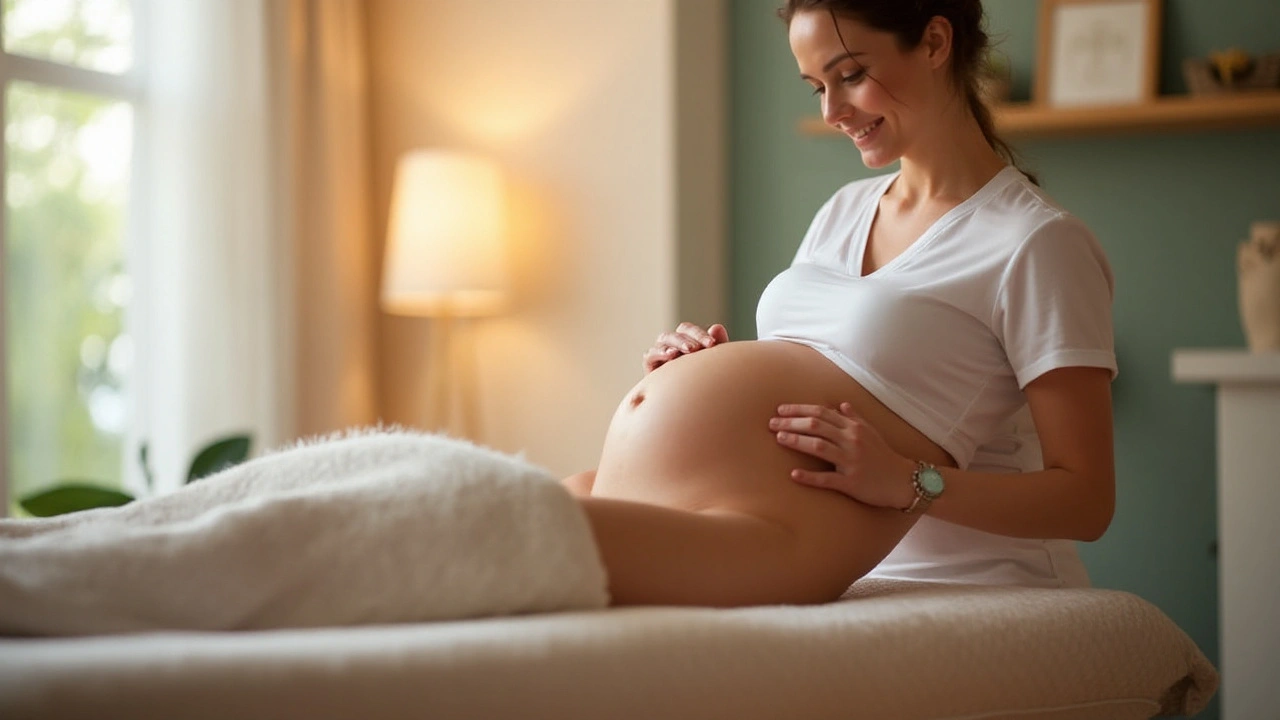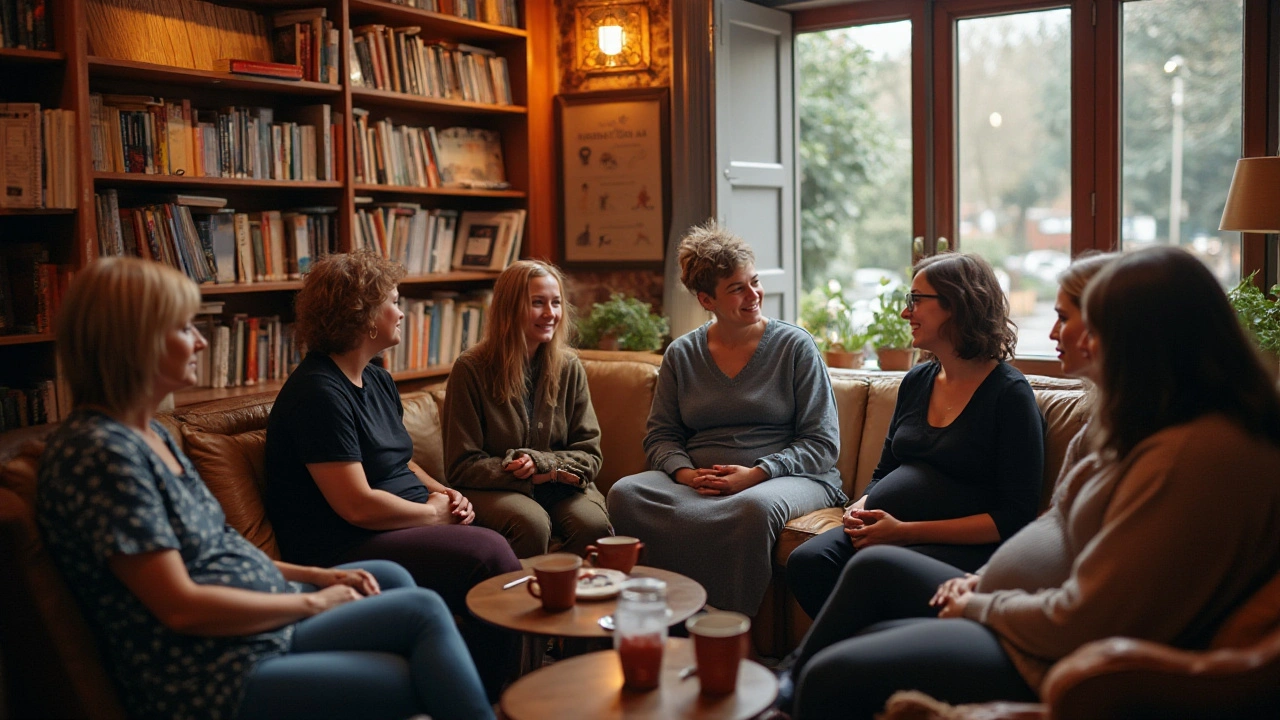Exploring the Safety and Benefits of Rolfing During Pregnancy
 Oct, 20 2024
Oct, 20 2024
Pregnancy, a transformative and unique journey, often brings moments of discomfort and exploration for expectant mothers. Among the myriad of therapeutic practices available, Rolfing has piqued interest for its potential to offer comfort and support during these nine months.
Rolfing, a method of structural integration, aims to align the body's architecture, sometimes promising relief from chronic tension and pain. But a key question lingers: Is it safe for pregnant women? Understanding how this bodywork might integrate into prenatal care is crucial for those considering all available options to enhance their pregnancy experience.
This piece sheds light on Rolfing's safety during pregnancy, examining both the possible advantages and the risks, to guide mothers-to-be as they ponder preventive and relief measures. Expert advice is always encouraged, but informed choices begin with knowledge. Let's explore whether Rolfing might be a gentle ally on this incredible journey.
- Introduction to Rolfing and Pregnancy
- Potential Benefits of Rolfing During Pregnancy
- Risks and Considerations
- Consulting with a Professional
- Tips for Expectant Mothers Considering Rolfing
Introduction to Rolfing and Pregnancy
Rolfing, named after its creator Dr. Ida Rolf, is a unique approach to body alignment that has fascinated the alternative wellness community for decades. Essentially, it is a series of ten sessions designed to align the body's posture by manipulating the connective tissues known as fascia. This technique promises not only physical relief but also a sense of emotional and mental clarity, which can be particularly appealing to pregnant women navigating the complexities of this transformative phase of life. The idea behind Rolfing is that by structurally realigning the body, the body's energy and function improve, which sounds like a dream to those carrying the weight of a growing child and the accompanying adjustments.
Pregnancy introduces a shift in the body's center of gravity and a loosening of joints due to hormonal changes, sometimes leading to discomfort or more severe postural issues. For expectant mothers, the promise of any technique that can help ease tension and improve mobility is often highly attractive. Rolfing could potentially help by offering better body alignment, thus addressing some common pregnant-related aches and pains. However, it's important to consider whether this method is genuinely safe during pregnancy and what modifications might be necessary.
It's interesting to note that not all practitioners might agree on the safety of Rolfing during pregnancy. Some experts argue that, when performed by a certified and experienced Rolfer with pregnancy-specific training, this method can be adjusted to ensure safety, avoiding deeper pressure in certain areas. According to a 2023 survey conducted among alternative health practitioners, nearly 60% indicated making adjustments is crucial for accommodating the physiological changes experienced during pregnancy.
Moreover, anecdotal evidence suggests many pregnant women report relief from back pain, better posture, and even fewer tensions after their sessions, making Rolfing a subject of keen interest. Yet, as with any health practice, consulting with a healthcare provider and a qualified Rolfer who can tailor the sessions to individual needs is key. Ida Rolf once stated,
"When the body gets working appropriately, the force of gravity can flow through. Then, spontaneously, the body heals itself."This emphasizes her belief in the body's innate ability to recover with the right guidance.
While Rolfing could be part of a balanced approach to prenatal care, especially when combined with other gentle therapies like yoga or swimming, it’s pivotal to proceed with caution and understanding. Being informed about what to expect and ensuring that safety credentials are met helps pave the way for a more comfortable journey. Thus, learning how Rolfing fits into prenatal care offers insight into its potential merit and safety, ensuring mothers-to-be can make enlightened decisions.
Potential Benefits of Rolfing During Pregnancy
During pregnancy, the body undergoes a multitude of changes, some bringing discomfort that can linger for days. Many pregnant women are on the lookout for safe and natural ways to relieve these ailments and enhance their overall pregnancy experience. That's where Rolfing can potentially lend a helping hand. This unique form of bodywork focuses on aligning the body’s posture and structure. By carefully manipulating the connective tissues, Rolfing aims to create harmony in the body, which could offer pregnant women much-needed relief from the physical strain of carrying a growing baby. As the pregnancy progresses, the spine and pelvis endure significant stress, often leading to common discomforts such as backaches and pelvic pain. Rolfing has been reported by some to alleviate these aches, offering the body a chance to recalibrate and adjust to its new form.
One of the key benefits touted by proponents of Rolfing for pregnant women is its potential to improve posture. As the body shifts with the added weight of pregnancy, posture often deteriorates, causing pain in the back and shoulders. Rolfing works on releasing restricted fascia, which is the connective tissue enveloping muscles, allowing for improved alignment and posture. Better posture not only reduces pain but also helps create more room for the baby, promoting a healthier pregnancy. Some women have found that this type of bodywork helps in relaxing tightened areas in their bodies, which had become a source of discomfort and tension. A study conducted in recent years suggested that prenatal bodywork can encourage relaxation, resulting in less back pain and other musculoskeletal complaints, particularly prevalent in the second and third trimester of pregnancy.
"Pregnancy is an extraordinary time when the body achieves what some might consider impossible feats. Rolfing can support this process by optimizing how structural components align and interact," shared an expert in prenatal wellness. Her experience has led many to explore Rolfing as part of their antenatal routines, finding comfort and ease in unexpected ways.
In addition to physical benefits, there’s a possibility that Rolfing could contribute positively to mental health during pregnancy. The process of Rolfing fosters a deepened awareness of the body and its sensations, potentially leading to a state of mindfulness and reduced anxiety. Many expectant mothers find that their perceptions of stress and unease diminished following Rolfing sessions, which could add a layer of emotional resilience during such an eventful time. This mind-body connection is essential when considering any therapeutic option during pregnancy, as both physical and mental health contribute significantly to the overall pregnancy experience.
It’s important to note that each pregnancy is unique, and what works for one expectant mother might not work for another. Pregnant women interested in incorporating Rolfing into their wellness routine should have an open discussion with their healthcare provider. Together, they can consider individual circumstances, health needs, and whether this practice aligns with their pregnancy care plan. Understanding the intricacies and potential advantages of Rolfing during pregnancy empowers mothers-to-be to make informed decisions about their health, ensuring they take steps that support both their well-being and that of their growing baby.
| Rolfing Benefits | Impact on Pregnancy |
|---|---|
| Improved Posture | Reduces back and shoulder pain, creates space for the baby |
| Alleviation of Aches | Relieves musculoskeletal discomfort associated with pregnancy |
| Mindfulness | Enhances mental well-being, reduces stress and anxiety |

Risks and Considerations
When considering Rolfing during pregnancy, it's important to weigh both the potential benefits and the risks. While many women have reported positive experiences, it's essential to be aware of the concerns that come with this therapy. Pregnancy is a period of constant change, where both the physical and emotional transformations can be overwhelming. As the body adapts, it becomes crucial to understand how Rolfing might interact with this dynamic process.
Potential risks of Rolfing during pregnancy often stem from the bodywork's deep tissue techniques. This form of manipulation can sometimes be intense, which might not be suitable during the heightened sensitivity of pregnancy. There is a concern that deep tissue work could increase discomfort, rather than alleviate it, due to the tenderness that some women experience. Given that Rolfing focuses on realigning bodily structures, it's essential to ensure that the pressure applied does not surpass the expectant mother's comfort level. Consultation with a healthcare provider who understands the pregnancy context is key before diving into this therapy.
"It's imperative to treat the pregnant body with utmost gentleness, understanding that every woman's experience is different and what works for one might not work for another," emphasizes Dr. Emily Carter, an obstetrician based in Sydney.
Beyond discomfort, it's also worth noting that improper administration of Rolfing can lead to adverse outcomes. If not performed correctly, there could be unintended pressure on blood vessels or nerves, which is a potential risk during pregnancy. Moreover, there are anatomical shifts occurring that change the location of tissues and organs, meaning the practitioner must be particularly skilled in prenatal care.
An important consideration is the trimester during which a woman is contemplating Rolfing. The first trimester is a period of significant risk, with many healthcare providers recommending caution with physical manipulation. By the third trimester, as the body prepares for labor, the need for gentler and more supportive techniques becomes evident. Additionally, emotional considerations play a role; a woman must feel secure and assured during this phase to truly benefit from any form of body therapy.
The decision to integrate Rolfing into prenatal care should involve discussions not only with practitioners experienced in this therapy but also with obstetricians who can provide guidance tailored to one’s personal pregnancy journey. Combining professional advice with personal intuition is perhaps the most prudent path forward for expectant mothers contemplating Rolfing.
Consulting with a Professional
When considering Rolfing as a part of prenatal care, the importance of consulting with a skilled professional cannot be understated. Pregnancy brings unique challenges and changes, and understanding how Rolfing can fit safely into this phase requires expert guidance. A certified Rolfer, familiar with the intricacies of working with pregnant bodies, can assess personal needs and conditions, ensuring each session is both safe and beneficial. Such a professional can tailor the approach to a client's trimester and any pregnancy-specific complaints, providing relief while maintaining safety.
In Australia, there is a growing network of Rolfing professionals, some of whom specialize in prenatal care. It's crucial to check the credentials of any practitioner, ensuring they are certified by a reputable institution. Licensing and years of experience can often serve as indicators of a practitioner's expertise. Pregnant clients should openly communicate any concerns or medical conditions with their Rolfer, enabling a tailored and informed experience. An open line of communication ensures adjustments can be made to the standard approach, accommodating your specific safety and comfort needs.
Given the varied responses to bodywork during pregnancy, some professionals recommend integrating feedback techniques that allow for session adjustments as needed. For example, a Rolfer might use a gentler touch or modify traditional techniques to ensure that the pregnant client's experience is both comfortable and effective. Studies indicate that bodywork tailored to a pregnant body can help alleviate discomfort and even improve mood. However, these benefits rely heavily on the practitioner's ability to adapt to each unique situation.
Dr. Emily Harper, a naturopath with a focus on maternal health, once remarked, “Having the right guide through bodywork therapies such as Rolfing can turn a good pregnancy experience into a great one. The key lies in the professional’s ability to listen and adapt, making safety and comfort their top priorities.”
For those considering Rolfing during pregnancy, seeking out a practitioner who can demonstrate a record of successful treatments with pregnant clients can be very reassuring. Conversations with these professionals should cover topics like personal health history, specific pregnancy discomforts, and desired outcomes from the sessions. Additionally, prospective clients should inquire about the practitioner's approach and their experience with similar cases.
It is also prudent to discuss Rolfer recommendations with a primary healthcare provider, such as an obstetrician or a midwife. These medical professionals can offer additional insights and opinions, ensuring a cohesive care plan that incorporates all perspectives. By collaborating with both medical and Rolfing professionals, expectant mothers can create a holistic, supportive environment tailored to their unique needs and well-being.

Tips for Expectant Mothers Considering Rolfing
Embarking on the path of Rolfing during pregnancy can be both an exciting and nurturing choice, yet it requires careful consideration. The practice centers around aligning the body's connective tissue, known as fascia, to release stress and improve posture. For some pregnant women, this can mean some relief from common aches associated with carrying a child, like back pain and shoulder tension. However, every pregnancy journey is unique, and what works wonders for one mother may not be suitable for another. Listening to one’s body is not merely recommended, it's imperative. Working closely with healthcare providers ensures choices align with one's prenatal health.
Firstly, it's important to choose a qualified Rolfer who possesses experience in working with pregnant women. The American Structural Integration Association sets professional standards and might be a good starting point to find a certified Rolfer familiar with pregnancy's unique physical challenges. Discussing any specific pregnancy-related concerns upfront is crucial. A trustworthy practitioner will never hesitate to adapt their techniques to ensure comfort and safety. That said, initial sessions might mainly focus on gentle touch rather than deeper tissue work, often depending upon the pregnancy stage. It's usually advocated to avoid Rolfing during the first trimester when the body is adapting to its new state.
Testimonials from those who've experienced Rolfing during pregnancy often speak of a renewed sense of balance and relief. Sarah, a mother of two, shares, "
Rolfing helped me reconnect with my changing body. I gained newfound confidence in my posture and movement as my pregnancy progressed." Such firsthand accounts may offer reassurance, highlighting the practice's potential benefits. While anecdotal, these reflections underscore the importance of individuals making managed, informed decisions. Still, what works for Sarah might not fit another expectant mother, necessitating personalized care and attention.
Another key consideration involves integrating Rolfing with other prenatal care routines. Combining this practice with yoga or Pilates can further enhance body alignment and flexibility, potentially supporting a smoother pregnancy journey. Therefore, seeking programs or classes that address prenatal needs is advisable. Before starting, though, discussing with one's obstetrician is pivotal to ensure no contraindications exist based on individual health conditions, to secure peace of mind and optimal safety. Additionally, being open about one's limitations during Rolfing sessions allows for adjustments that cater exclusively to that individual experience.
Lastly, relaxation and patience play major roles in not just Rolfing but all pregnancy journeys. Time spent focusing on self-care can improve both physical and mental well-being, essential for both parent and baby. Remember, consulting healthcare professionals is never a step to skip when considering Rolfing during pregnancy. Proper research paired with expert guidance truly prepares expectant mothers to make the right decision, one that best suits their bodies and their journeys. After all, pregnancy, as much a physical transformation, is a journey of empowerment, and whatever supports a mother's well-being ultimately benefits both her and her future child.
